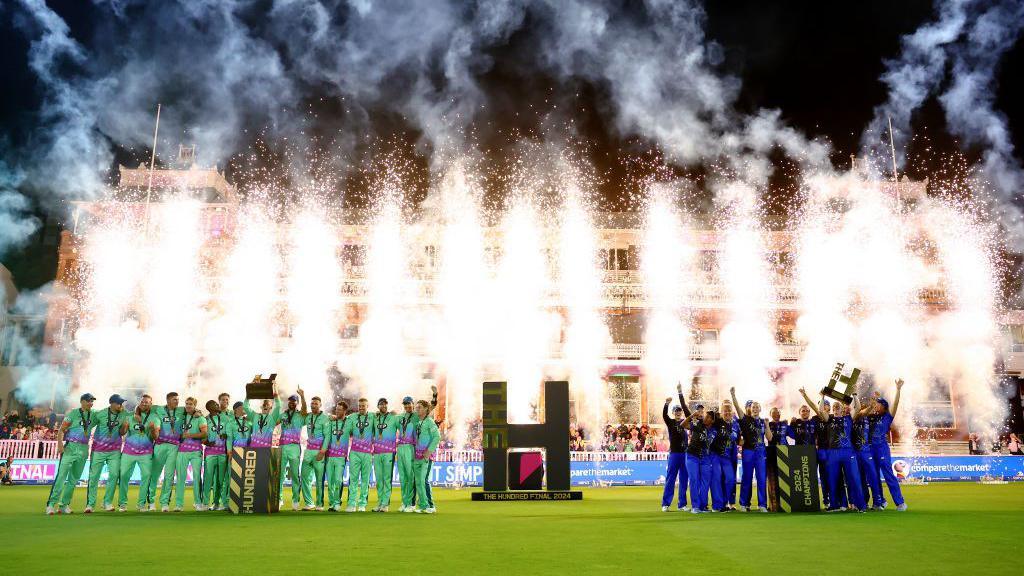What next for The Hundred?

More than two million people have attended matches since The Hundred began in 2021
- Published
Tradition is not a word usually associated with The Hundred.
But the sight of the men's and women's champions standing side by side on the Lord's outfield, enormous trophies held aloft as fireworks go off around them, has become a fixture of the British cricketing summer.
With the fourth edition of the tournament at an end, though, and stakes in all eight teams set to be sold this autumn, there is a sense of the unknown surrounding its future.
What is certain is The Hundred does have a future.
The England and Wales Cricket Board (ECB) announced that 540,000 tickets were sold for this year's tournament, taking the total beyond two million over the first four years.
Of those, more than a million attended women's games and there were record crowds for women's matches at seven of the eight grounds used in The Hundred in 2024.
For all that the competition continues to split opinion, confirmation that 41% of tickets this year were sold to families and 30% to people new to cricket suggests it has been successful in its aim of bringing people to the sport.
Despite that, TV viewing figures were down on previous years. Although being up against the Olympics for two weeks in the middle of the tournament, perhaps that is to be expected - and the BBC's coverage of the men's final still attracted almost half a million more viewers than the 2023 final.
ECB agrees to sell Hundred teams later this year
- Published30 May 2024
Spirit edge Fire in thriller to win The Hundred
- Published18 August 2024
Invincibles take down Brave to retain Hundred title
- Published18 August 2024
Women's final highlights
There is little that is likely to put off those interested in investing in the teams.
Owners of all 10 Indian Premier League (IPL) franchises are expected to bid, while there is believed to be interest from North America – including Hollywood actor and Wrexham owner Ryan Reynolds, according to reports, external.
The eight hosts of the teams will be given a 51% stake, which they can sell or keep, but the remaining 49% in each team is definitely up for grabs and will sold by the ECB.
Investment is coming then but what follows is far less clear.
When IPL owners have bought teams in other franchise leagues, it has often resulted in name changes and the expectation is The Hundred will be no different.
So we might not see London Spirit and Oval Invincibles defending their titles, rather it could be London Royals and Oval Capitals.
Of course, the hope would be that the money brought in is used to entice the world's top short-format players to England for a month each summer.
That need is particularly urgent in the men's competition because, while The Hundred can rightly claim to attract the leading women's players from across the globe, that is simply not the case for the men.
Previously it was the Caribbean Premier League that proved more tempting to some big names; this year there was a clash with Major League Cricket in the US - something that is likely to occur again.
And while Pakistan eventually prevented him from playing anywhere, Shaheen Afridi pulled out of his deal with Welsh Fire in favour of turning out in Canada's Global T20 tournament.
Tie-ins with IPL teams should help persuade more stars to join. More money will help too. But the competition from the US and Canada is going nowhere.
The Hundred 2024: Oval Invincibles retain title after beating Southern Brave
One way to ward them off would be to lose the draft system and then set salaries for each contract in favour of an IPL-style auction.
In terms of competitiveness though, the draft has worked well as the two finalists in the women's competition this year would attest.
Both Fire and Spirit struggled in the early years but, similarly to US sports, high draft picks have enabled them to reshape and develop their squads to compete.
Another sign of that competitive balance is the number of close games this year, including three ties and the tournament's first Super Five in the men's Eliminator.
Whether anything is done that might alter that is just another question as yet unanswered.
We know the ECB will retain ownership of the competition itself and there is no indication The Hundred will expand beyond its existing eight teams until at least the end of the current broadcast cycle in 2028.
In theory, that locks in the 100-ball format for another four years as well.
But given it has not been adopted elsewhere and the phenomenon that is T20 cricket remains, the prospect of adding those extra 20 balls per innings, losing five-ball sets in favour of six-ball overs and suchlike will always be lurking.
The forthcoming changes, though, have the potential to put The Hundred front and centre again.
Let the debates begin.
- Published16 August
